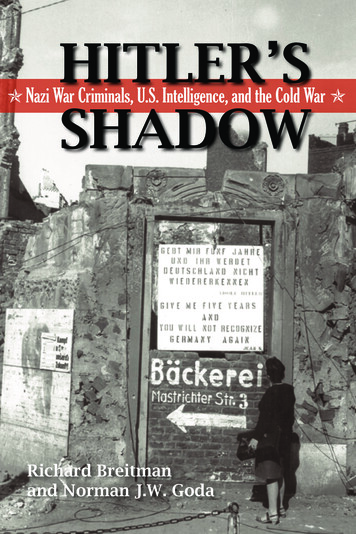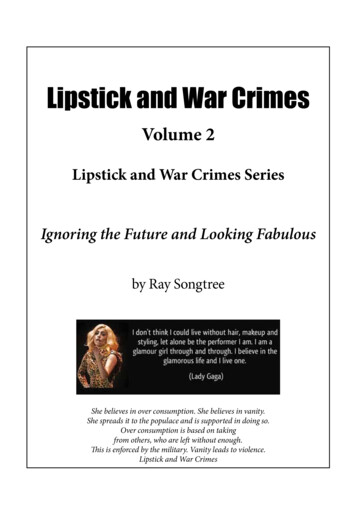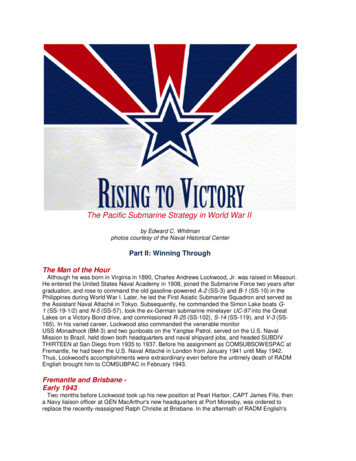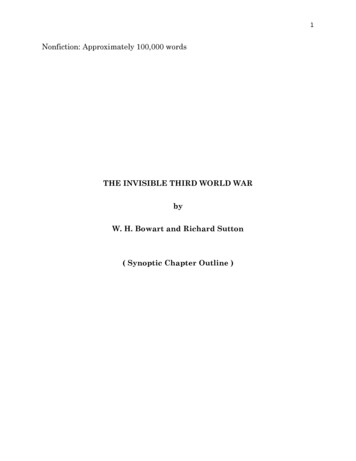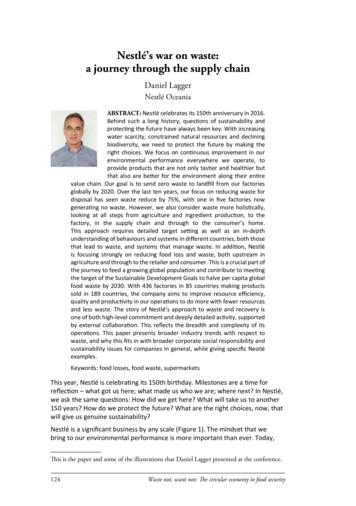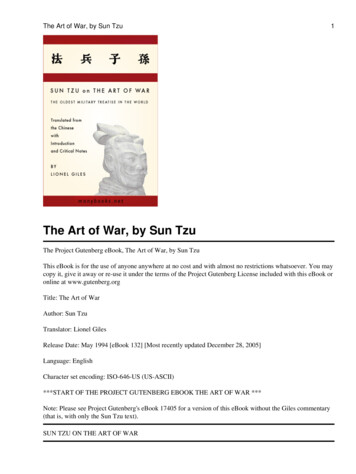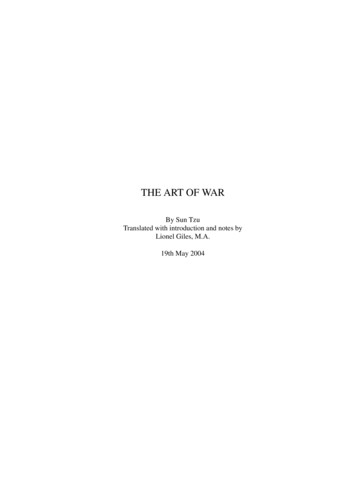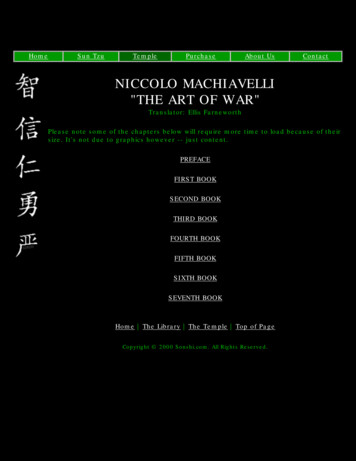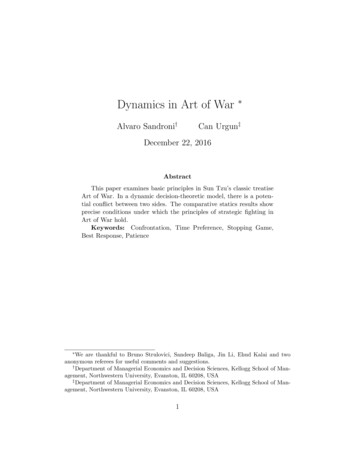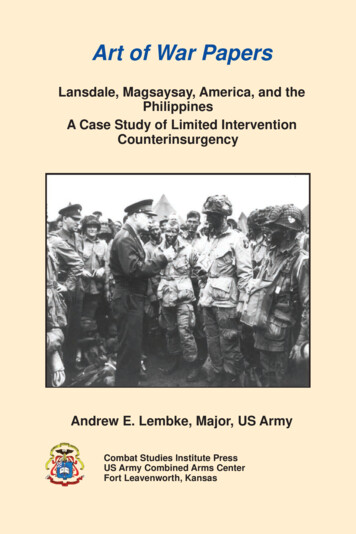
Transcription
View metadata, citation and similar papers at core.ac.ukbrought to you byCOREprovided by University of Groningen Digital ArchiveON WAR: CONCEPTS, DEFINITIONS, RESEARCH DATA - A SHORT LITERATURE REVIEW ANDBIBLIOGRAPHYJohan M.G. van der Dennen1 WAR: CONCEPTS AND DEFINITIONS1.1 IntroductionEven casual inspection of the literature reveals the following, incomplete, list of ‘war’ terms:limited war and total (or all-out) war, cold war and hot war, local war and world war,controlled and uncontrolled war, accidental war and premeditated war, conventional andnuclear war, declared and undeclared war, aggressive or offensive war and defensive war,general war and proxy war, international war and civil war, tribal and civilized war,preventive or pre-emptive war, protracted war, absolute war, war of liberation, war ofconquest, war of commerce, war of plunder, revolutionary war, political war, economic war,social war, imperialist war, guerilla war, psychological war, strategic war, counter-insurgencywar, dynastic war, monarchical war, ritual war, agonistic war, sacred war, instrumental war,genocidal war.Much of the complexity stems from the fact that the epithets refer to different aspects of, andperspectives on, war: e.g. war as condition, techniques of warfare, alleged motives and/orobjectives of war, or assumptions about belligerent behavior and the causes (causative factors,determinants, conditions, etc. ) of war (cf. Grieves 1977). War is a species in the genus ofviolence; more specifically it is collective, direct, manifest, personal, intentional, organized,institutionalized, instrumental, sanctioned, and sometimes ritualized and regulated, violence.These distinguishing features and dimensional delineations are not limitative. It should beperfectly clear, however, that war, or the state of belligerence, is a very special category ofviolence (van der Dennen, 1977).Some of the listed war terms reflect concern for attitudes and behaviour, linked withassumptions about the cause of war. The term ‘imperialist war’ reflects both an attitude aboutthe root causes of the war and an assumption about which States are guilty of having causedit. Also, much of the ‘nature of war’ is found not on the battlefield, but in the hostilebehaviour and attitudes that characterize a state’s foreign policy. Q. Wright (1942; 1965) callsattention to the discussion of this psychological aspect of war in Hobbes’ ‘Leviathan’, wherethe oscillations of war and peace are compared to the weather:As the nature of foul weather lieth not in a shower or two of rain, but in an inclinationthereto of many days together; so the nature of war consisteth not in actual fighting, but inthe known disposition thereto during all the time there is no assurance to the contrary.(Hobbes, 1651)Hobbes’ view raises an interesting question for modern students. Can peace be defined simplyas the absence of war (using ‘war’ in the sense of actual military combat) (Grieves, 1977)?1.2 Formal and material distinction of peace and warThe important point is that peace and war as facts differ formally rather than materially,and are distinguishable by their locus and implements rather than by their intrinsic
qualities as human behavior. Peace, it would appear, is the aggregation of chronic, diffuse,unorganized domestic conflicts: war is conflict, acute, organized, unified and concentratedat the peripheries of a society’s habitat. (Kallen, 1939)War and peace differ not in the goals pursued, only in the means used to attain them.(Barbera, 1973)Clausewitz’s formula - war is the continuation of policy by other means - has beenreplaced by its opposite: policy is the continuation of war by other means. But these twoformulas are, formally, equivalent. They both express the continuity of competition and theuse of alternately violent and non-violent means towards ends which do not differ inessence. (Aron, 1966). the nature of war itself has changed. In particular there is no longer a dividing linebetween a state of peace and a state of war. (Eccles, 1965)Behind both phenomena, war and peace, lies the same dimension of power. (Barbera,1973)Many political realists point out that the common basis of policy in both peace and war,namely the quest for power, makes them two inseparable parts of the same social activity.Blainey (1973) contends that the causes of war and peace dovetail into one another: “Warand peace are not separate compartments. Peace depends on threats and force; often peaceis the crystallization of past force.” Or formulated most succinctly: “In a system of powerpolitics, there is no difference in kind between peace and war”. (Schwartzenberger, 1950)War is a means of achieving an end, a weapon which can be used for good or for badpurposes. Some of these purposes for which war has been used have been accepted byhumanity as worthwhile ends: indeed, war performs functions which are essential in anyhuman society. It has been used to settle disputes, to uphold rights, to remedy wrongs: andthese are surely functions which must be served. One may say, without exaggeration, thatno more stupid, brutal, wasteful or unfair method could ever have been imagined for suchpurposes, but this does not alter the situation. (Eagleton, 1948)These formulations are reminiscent of Ambrose Bierce’s sardonic definition of “peace” as: “aperiod of cheating between two periods of fighting” (Devil’s Dictionary), or Orwell’s famousdictum from 1984: “Peace is War”.Diametrically opposed to the vista of peace and war as a bipolar continuum is the view of asharp and clear-cut borderline existing between the two conditions, thus implying aboundary-transgression in the transition from one state of affairs to the other. Brodie (1973),for example, states:Although war represents human violence in its most intensive form, it is not simply humanviolence. It is something else besides, something with a distinctive and quite specialconfiguration. The characteristics of this configuration cover a wide variety of phenomena,including the following: First, wars have tended, since antiquity, to have a clear and sharpbeginning and an equally clear and sharp ending; and various ceremonials have beeninvolved both in the initiation and the termination of war.
The most outspoken advocate, perhaps, of this view is Wells (1967), who succinctly affirms:“Notions of some limbo between war and peace are either contradictory or unintelligible”.Or, as it was stated in classical times: “Inter bellum et pacem nihil medium”.1.3 The socio-political definition of warAccording to international law, war, in principle, can only take place between sovereignpolitical entities, that is, States. War is thus a means for resolving differences between units ofthe highest order of political organization. The majority of those who have been concernedwith war as a socio-political phenomenon have also adopted as their basic premise that thereis a fundamental difference between domestic conflicts, for which there are normallymechanisms for peaceful resolution, and international conflicts, which occur in a state ofanarchy. Wars have been seen to involve directly State institutions, such as the foreign officeand the armed forces. Since war is put in an international context, the stakes of war may bethe life and death of States (Aron, 1966).This general outlook on war as an international or inter-State phenomenon has been shared bymany students, regardless of their professional background as political scientists, historians,sociologists, psychologists or military analysts. The school of political realism maintains thatnation-States can only realize their national interests by demonstrating their willingness tofight and by making use of wars of various degrees of magnitude as an instrument of nationalpolicy to achieve legitimate ends (Lider, 1977; Nobel, 1977).Von Clausewitz (1911) defined war as “an act of violence intended to compel our opponentsto fulfil our will”, and elsewhere he emphasized the continuity of violence with other politicalmethods: “War is nothing but a continuation of political intercourse, with a mixture of othermeans.”Sorel (1912) defined war as a “political act by means of which States, unable to adjust adispute regarding their obligations, rights or interests, resort to armed force to decide which isthe stronger and may therefore impose its will on the other”.Kallen (1939) seems to favour a political definition of war when he writes: “If war may bedefined as an armed contest between two or more sovereign institutions employing organizedmilitary forces in the pursuit of specific ends, the significant term in the definition is organized’.” He further adds that this organization of the contending armed forces extends backbehind the battle lines and tends in modern wars to embrace all civilian activities, such as theindustrial, productive, and commercial, and also the social interests and individual attitudes.Kallen (1939) criticizes von Clausewitz’ (1911) definition of war as “an act of violence forthe purpose of compelling the enemy to do what we will” as too general and indefinite. Hesays that “this definition might apply also to much that is called peace, particularly in sport,business and finance. It might apply to anybody’s act of violence, whenever it occurs. Aslimited to war, it applies to pre-Napoleonic and pre-industrial times and intentions, when warwas a castle enterprise, and a gentleman’s game”.A. Johnson (1935) defines war as “armed conflict between population groups conceived of asorganic unities, such as races or tribes, states or lesser geographic units, religious or politicalparties, economic classes”. This definition may, according to Bernard (1944), be regarded asapproximately sociological because it does not limit the armed conflict to political units but
includes any type of population units which is capable of resorting to arms as a method ofsettling disputes. Perhaps the definition is too general, since it does not specify the duration ofthe conflict or the magnitude of the conflicting parties. As it stands this definition could bemade to include riots.B. Russell’s ( 1916) definition of war as “conflict between two groups, each of whichattempts to kill and maim as many as possible of the other group in order to achieve someobject which it desires” is even more general and uncritically inclusive. Russell states theobject for which men fight as “generally power or wealth”.Wallace (1968) considers war to be “the sanctioned use of lethal weapons by members of onesociety against members of another. It is carried out by trained persons working in teams thatare directed by a separate policy-making group and supported in various ways by thenon-combatant population”.Ashworth (1968): “Mass or total war may be defined as a type of armed conflict betweenlarge nation-States in which populations and resources are rationally and extensivelyorganized for conquest. It is important to note that populations are mobilized both in terms ofactivities and psychological states: the former implies comprehensive military and civilianconscription; the latter implies the systematic development of belligerent and hostile attitudestowards the enemy among all or most of the population.”Deutsch and Senghaas (1971): “By ‘war’ we mean actual large-scale organized violence,prepared and maintained by the compulsion and legitimacy claims of a State and itsgovernment, and directed against another State or quasi-State, i.e. a relatively comparablepolitical organization”.Barringer (1972) considers war to be “one possible mode of policy activity aimed ateffectively and favourably resolving an ongoing conflict of interests. In this sense war is butone of numerous conflict procedures, others being negotiation, conciliation, mediation,arbitration, and adjudication. It is merely a particular subset of the larger set of all conflictmodes, encompassing all the socially (if not legally) recognized situations in which armedhostilities of considerable magnitude are conducted on a systematic and continuing basis bythe armed forces of two or more political factions, organizations, nations, governments, orStates. Because the term ‘war’ carries legal implications and connotations that no politicalbody cares any longer to suffer or risk publicly, the de facto situation of war will be referredto as hostilities’.Bernard (1944) attempts an all-purpose definition of war which is neither so general that it isindefinite and vague nor so detailed that it is confusing. It may be stated as follows: “War isorganized continuous conflict of a transient character between or among collectivities of anysort capable of arming and organizing themselves for violent struggle carried on by armies inthe field (or naval units on water) and supported by civil or incompletely militarizedpopulations back of the battle areas constituted for the pursuit of some fairly well-definedpublic or quasipublic objective.”This objective is of course not always defined to the satisfaction of all concerned and it isliable to change according to circumstances during the continuance of the struggle. But uponthe popular understanding of these objectives depends in large measure the degree and loyaltyof the people’s support. While the war is between or among organized groups or
collectivities, the fact of organization implies leadership (generals, military staffs, civilianeconomic, political and moral organizers and leaders) and collective effort, both military andcivilian. The need for discipline and coordination also implies obvious regimentation withinthe army and of the belligerent populations as wholes, as well as more subtle manipulation ofthe psychological and social factors contributing to both military and civilian morale(Bernard, 1944).Beer (1974) presents a minimum definition of war as “the presence of direct internationalviolence”.Crew (1952) defines war “as organized, intraspecific conflict, in which force, coercion isdisplayed”.Similar concise “political” definitions are presented by White (1949), Malinowski (1936;1941), Mead (1964), Bouthoul (1959; 1962), Sokol (1961), Nieburg (1963), Valkenburgh(1964), Withey and Katz (1965), Plano and Olton (1969), van Doorn and Hendrix (1970),Czempiel (1971), Krippendorff (1971), Zsifkovits (1973), Barbera (1973), Harrison (1973),Van den Berghe (1978), The Encyclopaedia Brittanica, Oxford Dictionary, etc.Bozeman (1976) has argued that the term “international war” no longer refers exclusively toviolent conflicts between States. Rather, he says,It now stands also for a broad spectrum of armed belligerence within the State, rangingfrom sporadic urban guerilla activities to civil wars, wars of liberation and secession,insurrections and other revolutionary uprisings, many of which are initiated andmaintained in behalf of causes espoused by foreign principals. Moreover, thisinterpenetration of the domestic and foreign environments effaces altogether theconventionally accepted lines between legitimate and illegitimate force, and puts inquestion the theoretically established distinctions between war and peace. Theseinterlocking conditions support the conclusion that the State, having forfeited importantcontrolling functions customarily ascribed to it in world affairs, can no longer be regardedas a reliable medium for realistic differentiation among types of war and between theconditions of war and peace.Next, the erosion of the State as the fundamental, shared norm of political organization,together with general acquiescence in the coexistence of States and anti-State bodies asequal actors in foreign policy arenas, has gradually but ineluctably led also to thedevaluation of the two State-based superstructures that provide the context for officialforeign relations: (1) the world society of sovereign, equal States and (2) the law ofnations, which stipulates the rights and obligations of these States.Bozeman proposes civilization as an alternative:Today, several factors combine in support of civilization as the proper focal point of warresearch. As preceding comments on the variegated forms of war and violence throughoutthe modern world have suggested, the Occidental model of the State has ceased to be areliable indicator or measure of such phenomena as international war and internal war.Indeed, a survey of actually functioning power centres makes it doubtful whether one canstill legitimately view the nation-State as the politically controlling, and hence unifying,organizational norm in international relations. Observations such as these, together withreflections on the conspicuous failure of recent war-related policies of the United States,
imply rather that we have entered an era in which the interacting, independent units are sodisparate that references to an “international order” are invalid. These symptoms of theerosion of the State seem to make it mandatory that we find other or additional ways todetermine the configuration of an alien society.Civilization recommends itself in this respect because it is more comprehensive as anordering concept than the State: it can cover a host of political formations - armed bands,liberation fronts or empires; anarchies or despotisms; transterritorial commonwealths ofcommodity producers, financiers or religionists; as well as multinational political parties.Next, also in contrast to the State, a civilization is more enduring in time, even as it isusually less precisely defined in space. And finally, civilization is today a more neutralreference than the State because, contrary to the latter, it is not associated with typicallyOccidental norms and values. (Bozeman, 1976)1.4 Quantitative criteria in the definition of warIf we are to take this view that war is simply one form of political intercourse, how do weknow when the line dividing nonviolent conflict from violence has been meaningfullycrossed? We probably will not know because of the subtle shades of progression, butfollowing the Clausewitz line of thinking, perhaps the dividing line is immaterial, as war isultimately a question of political attitude and subject to all the vagaries of time and place. Oneinteresting attempt to fix the threshold quantitatively was made by Richardson (1960) whotried to arrange all “deadly quarrels” on a continuum of violent conflict, ranging from onekilled (murder) to ten million killed (Second World War). The threshold of war was crossedwhen deaths went over 1000.Singer and Small (1972) and Deutsch and Senghaas (1973) call “war” any series of eventsthat meets the following three criteria:(1) Size: it results in at least 1000 battle deaths (not counting, therefore, the indirect victimsthrough famine, lack of shelter, and disease).(2) Preparation: it has been prepared in advance , and/or is being maintained, by large-scalesocial organizations through such means as the recruitment, training and deployment of troopsthe acquisition, storage and distribution of arms and ammunition, the making of specific warplans and the like, and(3) Legitimation: it is being legitimized by an established governmental orquasi-governmental organization, so that large-scale killing is viewed not as a crime but as aduty.The definition just given would exclude small incidents among organized forces, large butunorganized, poorly legitimated and transitory riots. It would include, however, many largeand sustained civil wars, since the parties to such wars tend to assume quasi-governmentalfunctions in preparing, maintaining, organizing, and legitimating the process of large-scalekilling.While qualification is helpful in standardization, the cut-off points for various categories arelikely to remain highly arbitrary. Besides, the basis for quantification (in this case deaths)may not take into account other equally significant dimensions of the use of force. Economicwar or psychological war may, for example, produce drastic and far-reaching political andmilitary consequences not measurable by battlefield casualties (Grieves, 1977).
1.5 The judicial conception of warClosely related to a political definition of war is the judicial conception. Q. Wright (1942;1965) describes war as “a legal condition which equally permits two or more hostile groups tocarry on a conflict by armed force”. The Marqués de Olivert is quoted as declaring that “waris a litigation or suit (litigio) between nations that defend their rights, in which force is thejudge and victory is the judicial award”. This analogical and figurative characterization of waris perhaps more literary than factual (Bernard, 1944).Eagleton (1933), after quoting numerous legal definitions of war from Cicero to the present,comes to the conclusion that “the preceding discussion leaves one with a great deal ofuncertainty as to the meaning of war. [and that] to define war [juridically]. would presentdifficulties. Furthermore, it is desirable to eliminate the word, with all its unpleasantpsychology, from the vocabulary of international affairs”.Q. Wright (1926) defined war in the legal sense as “a condition or period of time in whichspecial rules permitting and regulating violence between governments prevail, or a procedureof regulated violence by which disputes between government are settled”, and war in thematerial sense as “an act or a series of acts of violence by one government against another, ora dispute between governments carried on by violence”.In his classic “A Study of War” (Q. Wright, 1942; 1965) war in the broadest sense wasdefined as “a violent contact of distinct but similar entities. In this sense a collision of stars, afight between a lion and a tiger, a battle between two primitive tribes, and hostilities betweentwo modern nations would all be war”. He therefore proposes a narrower definition: “the legalcondition which equally permits two or more hostile groups to carry on a conflict by armedforce”. He also noted the convergence with the traditional legal concept of war:International lawyers and diplomats have usually followed Grotius’ conception of war as “thecondition of those contending by force as such”, though they have often excluded from theconception duels between individuals and insurrections, aggressions, or other conditions ofviolent contention between juridical unequals. Furthermore they have insisted that “force”refers to military and naval activities, that is, to “armed forces”, thus excluding from thedefinition contentions involving only moral, legal, or economic force. With these refinements,the legal concept of war becomes equivalent to that adopted here.Kelsen (1942) has distinguished two basic modern interpretations of war, and in each of themit is assumed that the existence of war is a matter for objective determination. His concern iswith the legal status of war. According to the interpretation war is neither a delict nor asanction. It is not a delict because war is not forbidden by any general international law. Itfollowed, thus, that any State could war against any other State without violating any law.Obviously no State would violate its own laws in going to war, and, in the absence ofinternational law forbidding war, there could be no question of a delict. On the other hand,war cannot be a sanction either, since there is no international law authorizing war. Whileevery State authorizes its own wars and condemns its enemies, this hardly constitutes a legalstate of affairs. War is, thus, beyond legal praise or blame.The other position held that there was a general international law forbidding war on principle,except where an illegal act, a delict, had been committed. On this account war is eitherblameworthy, because it is a delict, or praiseworthy because it is a sanction.
In summing up this matter of the legal definition of war, Grob (1949) concluded that “therecan be no such notion as war in the legal sense”. And Wells (1967) adds: “If there were somesense in the expression ‘legal war’, the existence of some international body which assignedthe criterion for legality would at the same time make the expression otiose or contradictory”.1.6 The legal definition of warThose who stress the legal aspects of war maintain that a belligerent status impliessovereignty. A struggle can be considered a war only if the contenders are sovereign politicalunits (tribes, fiefs, empires, nation-States, etc.). A rebellion against a sovereign authority mayassume the character of a war, an internal one, only if the rebellious party succeeds inestablishing a structure for asserting the sovereign power it claims. A certain amount ofambiguity is involved, however, in defining the warring parties as both sovereign andpolitical. The point can be illustrated in the work of Quincy Wright.In “A Study of War” Q. Wright (1942; 1965) tries to combine the legal, sociological, military,and psychological views of war and offer a synthesis. The resulting definition holds that waris a state of law and a form of conflict involving a high degree of legal equality, of hostility,and of violence in the relations of organized human groups; in a simpler wording: war is thelegal condition which equally permits two or more hostile groups to carry on a conflict byarmed force. Similar definitions are presented at other points in his study. In one, he assertsthat war may be regarded “from the standpoint of each belligerent” as an extremeintensification of military activity, psychological tension, legal power, and social integration;and “from the standpoint of all belligerents” as an extreme intensification of simultaneousconflicts of armed forces, popular feelings, jural dogmas, and national cultures; he alsorepeats here the definition of war as a legal condition (p. 698). In another place he writes thatwar is at the same time an exceptional legal condition, a phenomenon of intergroup socialpsychology, a species of conflict and a species of violence (p. 700). In all three definitions,each of the four viewpoints is represented, but prominence is given to the legal aspect.In a later study (Q. Wright, 1955), he distinguishes between “war in the legal sense” and “warin the material sense”. The legal conception, which he calls the narrower of the two, describessituations in which the participating groups are equally permitted to combat each other withthe use of armed force. If war is seen in a material sense as armed struggle of considerablemagnitude without regard to the legal status of the contenders, then, Wright concludes, “warhas usually been employed by States as a method of international politics; it has also beenemployed by insurgents and rebels to gain independence, by governments to suppressdomestic and colonial revolts, and by international organizations to suppress aggression”.This is a description of war as a political instrument. A general definition of war has beenadded: “War is the art of organizing and employing armed force to accomplish the purpose ofa group”. In an article (Q. Wright, 1968), however, he once more repeats the assumption ofthe primacy of the legal concept of war.It may be suggested (Lider, 1977) that the ambiguity of Wright’s position derives from hiscombining the constituent elements of war as a social phenomenon (war as a phenomenon ofintergroup psychology, as a species of conflict, or a species of violence) with certain legalregulations to which war was submitted as it became institutionalized (cf. Kotzsch, 1956).The general impression that remains from his very valuable contribution to the study of war is
nevertheless that he was most concerned with what legal conditions had to be met before anarmed conflict could be called war.In a more obvious legal approach, Reves (1945) proposes the “social law” that war, which hedefines as fighting between units of equal sovereignty, takes place whenever and whereversuch units come into contact: the corollary to this view is that war ceases the moment sovereign power is transferred from the fighting equal units to a larger or higher unit. Hisconclusion is that the problem of the transfer of sovereignty is the sole cause and object ofwar.This is surely an excellent example of the dangers of legalism. Reves’s definition of war is sonarrow that it excludes the great majority of, what are commonly called, wars. Moreover, hiscontention that the transfer of sovereignty to a higher unit is the only result of each war isclearly invalidated by any fair test. His thesis may imply that the only way war can beprevented is by merging nations into a world-State, the single and highest sovereign power(Lider, 1977).A legal definition of war is also presented by Stone (1959): “War is a relation of one or moregovernments to at least one other government, in which at least one of such governments nolonger permits its relations with the others to be governed by the laws of peace”.More extended and less explicitly legal is Sorokin’s (1937) concept of war as “the breakdownof the crystallized system of relationships” between the States; and Elliott and Merrill’s(1961) “the formal disruption of the relationships that bind nations together in (uneasy)peacetime harmony”.Also the following two definitions seem to imply a judicial perspective (as a disruption of anormal, rule-governed, more or less peaceful state of affairs):Fried (1967) defined war as “the. condition which. permits two or more hostile groups tocarry on a conflict by armed means”.E.O. Wilson (1978): “War can be defined as the violent rupture of the intricate and powerfulfabric of the territorial taboos observed by social groups”.With minor variants, the most current legal definition of war is the following: War is “einzwischenstaatlicher Gewaltzustand zwischen zwei oder mehreren Staaten, unter Abbruch derfriedlichen Beziehungen” (Menzel, 1959; Verdrosz, 1964). Or, more comprehensive still:“krieg ist ein völkerrechtlicher Gewaltzustand unter Abruch der diplomatischenBeziehungen” (Zsifkovits, 1
war, dynastic war, monarchical war, ritual war, agonistic war, sacred war, instrumental war, genocidal war. Much of the complexity stems from the fact that the epithets refer to different aspects of, and perspectives on, war
